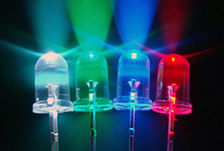 |
Date Announced: 14 Jul 2020
Study assesses the four major phosphor-LED types: ceramic, polymer, chip- on-board, and chip-scale.
Washington, DC, USA -- If current trends in research and development continue, LED lighting is projected to save 4.8 quads of energy annually by 2035. This figure could rise to 6.1 quads if U.S. Department of Energy (DOE) targets are achieved. To better inform our understanding of LED reliability over the course of a product’s lifetime, DOE has released the results of a study assessing the four major phosphor-converted LED (pc-LED) package types: ceramic-based, polymer-based, chip-on-board (COB) packages, and chip-scale packages (CSP).
Washington, DC, USA -- LED packages rarely fail abruptly (i.e., suddenly stop emitting light). In most cases, they experience parametric failures, such as degradation or shifts in either color or light output (e.g., luminous flux). In some applications, chromaticity stability—that is, the degree to which the light output maintains its color—is just as important as the light output itself. Think of a museum or retail store where multiple lamps are used to illuminate a wall, or a hospital or factory where objects are analyzed based on color.
To better understand chromaticity stability in LEDs, the DOE study evaluated four pc-LED package platforms for luminous flux and chromaticity maintenance, analyzing data sets from LM-80 testing of representative products from many Tier 1 LED manufacturers. The analysis, conducted by RTI International and LED Lighting Advisors, covered a total of 223 separate data sets. This study was an update of a 2015 DOE study that focused only on luminous flux maintenance.
Continued improvement
The new analysis found continued improvement across all LED package types. In total, 96% of the luminous flux values have an L70 (the point in time when light output has declined to 70% of initial output) of nearly 60,000 hours or longer. Perhaps the largest gains have occurred in polymer-based packages, where better materials have resulted in marked improvements in luminous flux maintenance, to the point where the performance of such packages is nearly the same as that of ceramic-based packages for drive currents ≤ 200 mA.
The current-handling capabilities of COB and ceramic-based packages have also improved significantly, and these package platforms exhibit excellent luminous flux maintenance at operational currents of 1,500 mA and higher. The newly introduced CSP package types exhibit luminous flux maintenance values in line with the other package platforms, especially at temperatures of 120°C and lower.
Chromaticity shift
The first step to assess chromaticity shift was to classify the chromaticity shift mode (CSM) behavior for the products. The analysis found that ceramic-based packages were most likely to exhibit yellow chromaticity shift, polymer packages were most likely to exhibit blue chromaticity shift, and CSP LEDs without polymer sidewalls were divided between blue shift and green shift, while CSP LEDs with polymer sidewalls were divided between yellow and blue shift behaviors.
Assignment of CSMs for COB packages was complicated by significantly different behaviors that made identification of the emergence phase difficult. This suggests that additional work is needed to understand chromaticity shift in COB LEDs. Overall, these findings indicate that improvements in package die and materials have reduced or delayed the impact of some known failure modes (e.g., delamination behavior in ceramic-based packages), making other chromaticity failure modes (e.g., warm-white phosphor stability) more important over time.
The second step in the assessment was to project long-term chromaticity coordinate shifts using the LM-80-15 data sets and TM-35-19. The ability of the TM-35-19 method to predict chromaticity shifts was evaluated through a series of six case studies. These studies found that TM-35-19 often provides conservative estimates of chromaticity shift magnitude (?u'v'), but is much less likely to produce a reliable estimate of chromaticity shift direction. The method appears to be more reliable when applied to longer-duration data sets that show at least the beginning of an emergence phase.
E-mail: Contact via website
Web Site: https://www.energy.gov/eere/about-office-energy-efficiency-and-renewable-energy
| © 2025 SPIE Europe |
|